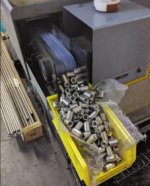avongil
Aluminum
- Joined
- Dec 31, 2014
- Location
- Easton, PA
This question comes up every once in a while, and I like to get some up to date input.
I have a Star SR20R II.. The issue is machining 304 and 316 or N60. These materials don't really take well to oil. The heat just stays in the material. The only way around it with oil is to use high pressure coolant to take as much heat out of it. It also cooks the oil and needs to be replaced often when doing this type of work.
What are your thoughts of using coolant in a swiss lathe? I am thinking of switching back to straight oil when the tough stainless jobs are done. Some say you cannot go back. Why? The water just sinks to the bottom and stays there.
My idea is to switch over to Hocut 8640 and have all machines in the shop run the same stuff. HOCUT(R) 8640 – Houghton International
I'm thinking of running a 20% concentration.
This has zero synthetic oil, so it should not rust anyting. Have been using it for two years on a lathe and it has not rusted anything at all.
The benefits are:
1 - faster cycle time - tons of heat removed
2 - Machine stability - machine does not heat up
3 - zero fire risk for overnight ops
4 - cost
5 - better tool life (10X more)
Downsides:
1 - more maintenance
2 - risk of bearing or electrical damage.
let me know if I am overlooking something silly. I don't really see a reason to use neat oil in a modern Swiss. This one has air constantly blowing through the bearings. Also bearings are super cheap for these machines, they are so small.
The benefits seem to well outweigh the risks. I want to be cautious the machine is expensive and not easy to replace with another one.
I have a Star SR20R II.. The issue is machining 304 and 316 or N60. These materials don't really take well to oil. The heat just stays in the material. The only way around it with oil is to use high pressure coolant to take as much heat out of it. It also cooks the oil and needs to be replaced often when doing this type of work.
What are your thoughts of using coolant in a swiss lathe? I am thinking of switching back to straight oil when the tough stainless jobs are done. Some say you cannot go back. Why? The water just sinks to the bottom and stays there.
My idea is to switch over to Hocut 8640 and have all machines in the shop run the same stuff. HOCUT(R) 8640 – Houghton International
I'm thinking of running a 20% concentration.
This has zero synthetic oil, so it should not rust anyting. Have been using it for two years on a lathe and it has not rusted anything at all.
The benefits are:
1 - faster cycle time - tons of heat removed
2 - Machine stability - machine does not heat up
3 - zero fire risk for overnight ops
4 - cost
5 - better tool life (10X more)
Downsides:
1 - more maintenance
2 - risk of bearing or electrical damage.
let me know if I am overlooking something silly. I don't really see a reason to use neat oil in a modern Swiss. This one has air constantly blowing through the bearings. Also bearings are super cheap for these machines, they are so small.
The benefits seem to well outweigh the risks. I want to be cautious the machine is expensive and not easy to replace with another one.


 ………...Me? I think I'd ask Star what brand & brew they recommend.
………...Me? I think I'd ask Star what brand & brew they recommend.